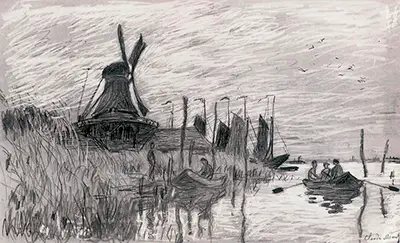Having left England, Monet travelled to the village of Zaandam, and spent his time there painting. During his stay he painted around 20 views of this picturesque town and its surrounding areas.
As an impressionist artist, Claude Monet painted ‘En plein air’ (In the Outside air) to depict the realism of the light interacting as never before, with the environment.
In his works he tries to show how the light interacts with the textures and colours of the scene before him. He would often use lighter colours as his base and apply darker tones to define and highlight the lighter and brighter shades.
His time at Zaandam was mostly overcast, so he chose a palette of colours to reflect the overcast light. By limiting the range of colours, he was able to recreate the overcast feel, and the fleeting properties of the light. In his work, Windmill at Zaandam, the overcast sky is a range of whites and browns, with some orange and grey as highlights.
The surface of the water reflects the sky, painted with a range white and reddish tones, giving it an orange hue in the foreground. The water’s surface becomes whiter as it moves toward the horizon. The windmill and sails are reflected using a light brown tone. The pole reflections are smudged blend of dark-brown, white and orange. The uneven edges of the reflected poles create a ripple effect.
The reeds on the river bank are an interplay of light and dark. At the base of the windmill, near the sail barges, the reeds are a light bright green, enhanced by the whiter sky. Towards the foreground, the colours are darker. A mid-green with some yellow highlights visible, create the reeds to the left of windmill in the foreground. Towards the water, more dark greens, browns and black are used to emphasize the shadows.
The objects in this work are painted in dark colours, with limited detail. They are silhouetted against the sky, emphasizing the light overcast sky. The windmill shows more details than other objects but is still only vaguely defined. It is painted in a neutral palette of browns, with some light and dark highlights. The figures too are painted in dark colours, with undefined edges.
Impressionists are known for their fast brushwork. This is obvious in the sky of this work. The quick multi-directional strokes give the sky a translucent effect, drawing the eye to the lighter portion of the sky. The columns of smoke, rising above the horizon, can be seen as short quick strokes, becoming broader and smudged as the columns rise to blend with the clouds.
Much has happened since the early days of the Renaissance, where we enjoyed the likes of Creation of Adam, Mona Lisa and School of Athens. Despite the contrast to modern styles, this remains the most influential period in European art.
Short and fast brush strokes are also visible in the reflected water surface in the foreground. The reed, building and sail reflections, are composed of short brush strokes. The reflected column of smoke, between the row boat and the bank, is composed of quick smudged strokes on the water’s surface, drawing the eye towards the horizon.


